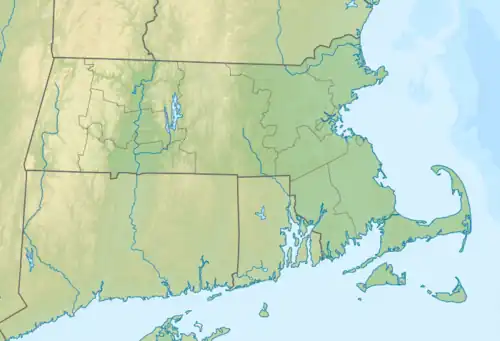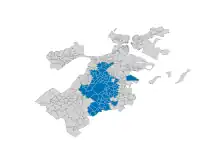Mandela, Massachusetts
Mandela was a proposed city that would have been formed as a result of some districts seceding from Boston, Massachusetts.[1][2][3]
Mandela County, Massachusetts | |
|---|---|
Proposed City | |
Interactive map outlining the Boston precincts that would have formed Mandela, Massachusetts in the 1986 and 1988 ballot question language. | |
 Mandela Location within the United States | |
| Coordinates: 42°21′29″N 71°03′49″W | |
| Country | |
| State | |
| County | Suffolk |
| Region | New England
|

The districts, including parts of Roxbury, Dorchester, Mattapan and the South End, were populated mainly by African-Americans and Latinos, and the movement was driven by Black community leaders. The name was inspired by South African anti-Apartheid activist and political prisoner, later President of South Africa Nelson Mandela.[4]
Background and impetus
Activists gathered in the summer of 1984 to discuss remedies to the imbalance of power they perceived between communities within the greater city of Boston, as it had expanded through annexations in the 19th century. Leaders spoke of the relationship between Black residents and City Hall as that of a "colony," in an era when apartheid in the Republic of South Africa, notions of community control were under discussion, and a decade after the upheavals created in Boston by efforts at school desegregation and busing.
Referendums in 1986
The proposal to create Mandela sought to carve out a new, 12-square-mile city in the heart of Boston, which would comprise about 22 percent of Boston's 600,000 population, including most of its black residents.
The Greater Roxbury Incorporation Project (GRIP) were the sponsors of the Mandela initiative; the co-leaders of the GRIP campaign were journalist and filmmaker Andrew Philemon Jones and architect Curtis Davis. Mel King was also a proponent, and ran in 1983 as mayoral candidate against then city council member, Raymond Flynn.[7]
Other community-based organizations in Boston doing work around local Black and Brown residents' land control included the Dudley Street Neighborhood Initiative (DSNI) and Greater Roxbury Neighborhood Authority (GRNA).
Jones said that Black neighborhoods had "a colonial relationship with the city of Boston" because they were not given adequate public funds. Opponents, including some of Boston's black ministers, Roxbury state representative Thomas Finneran and Mayor Raymond L. Flynn, claimed the new municipality would undermine gains and create a community with annual deficit of $135 million.[8]
A non-binding referendum question about succession appeared on the ballot in 1986, on November 4. Nearly 50,000 people voted in the referendum.[9] The proposal failed, with 73 percent voting against it. The measure did not win in any precinct, and fared worst in the predominantly Black neighborhoods.
1988 referendum and beyond
The plan was put back on the ballot in 1988, when it was also defeated.[9] In 1989, Jones proposed a longer-range commission that would study the impacts of turning a neighborhood into an independent city.[10]
In 2017, Epicenter Community held a panel discussion about the movement.[7]
Referendum results
| State Legislative District | 1986 Referendum [11] | 1988 Referendum [6] | ||||||
|---|---|---|---|---|---|---|---|---|
| YES | NO | TOTAL | % YES | YES | NO | TOTAL | % YES | |
| Third Suffolk | 1,280 | 3,624 | 4,904 | 26.1% | ||||
| Fifth Suffolk | 1,027 | 3,322 | 4,349 | 23.6% | 1,231 | 2,529 | 3,760 | 32.7% |
| Sixth Suffolk | 684 | 1,962 | 2,646 | 25.9% | 1,625 | 3,350 | 4,975 | 32.7% |
| Seventh Suffolk | 1,446 | 3,691 | 5,137 | 28.1% | 2,158 | 3,021 | 5,179 | 41.7% |
| Ninth Suffolk | 1,348 | 3,841 | 5,189 | 26.0% | 2,446 | 3,540 | 5,986 | 40.9% |
| Twelfth Suffolk | 1,460 | 3,819 | 5,279 | 27.7% | 2,211 | 4,027 | 6,238 | 35.4% |
| Thirteenth Suffolk | 1,055 | 3,301 | 4,356 | 24.2% | 1,971 | 4,781 | 6,752 | 29.2% |
| Fourteenth Suffolk | 1,585 | 4,371 | 5,956 | 26.6% | ||||
| Fifteenth Suffolk | 1,034 | 4,076 | 5,110 | 20.2% | ||||
| Seventeenth Suffolk | 1,191 | 3,266 | 4,457 | 26.7% | ||||
| TOTAL | 12,110 | 35,273 | 47,383 | 25.6% | 11,642 | 21,248 | 32,890 | 35.4% |
See also
Further reading
- Miletsky, Zebulon; González, Tomás (2016-09-22). ""Separatist City": The Mandela, Massachusetts (Roxbury) Movement and the Politics of Incorporation, Self-Determination, and Community Control, 1986–1988". Trotter Review. 23 (1). ISSN 2373-7743. (substantial and comprehensive article with extensive bibliography).
- Hogen-Esch, Tom. "Recapturing Suburbia: Urban Secession and the Politics of Growth in Los Angeles, Boston, and Seattle." Ph.D. diss. University of Southern California, 2002 (especially chapter 7, "The Greater Roxbury Incorporation Project," pages 229–285).
References
- Shlachter, Barry (1986-09-07). "Irate Blacks Pushing for Secession in Boston". Los Angeles Times. Retrieved 2020-08-18.
- Hornblower, Margot (1986-10-13). "In Boston, a Dream of Independence". Washington Post. ISSN 0190-8286. Retrieved 2020-08-18.
- Pattison-Gordon, Jule (2017-09-13). "Mandela, MA and the bid to separate from Boston". The Bay State Banner. Retrieved 2020-08-18.
- Kennedy, Marie; Tilly, Chris (1986). "The Mandela Campaign, An Overview". Radical America. 20 (5) – via EBSCO.
- Page, Clarence (1986-11-09). "Boston Chooses to Stay Intact". Chicago Tribune. Retrieved 2020-08-18.
- https://electionstats.state.ma.us/data/serve_file_pages_for_item/5607/BallotQuestion/
- "Mandela, MA and the bid to separate from Boston". The Bay State Banner. 2017-09-13. Retrieved 2020-08-18.
- Butterfield, Fox (October 12, 1986). "Bostonians Debating Drive to Carve Out a Black City". New York Times. Retrieved 17 August 2020.
- Miletsky, Zebulon; González, Tomás (2016-09-22). ""Separatist City": The Mandela, Massachusetts (Roxbury) Movement and the Politics of Incorporation, Self-Determination, and Community Control, 1986–1988". Trotter Review. 23 (1). ISSN 2373-7743.
- Hays, Constance L. (December 10, 1989). "Boston's Black Areas Mount New Secession Drive". New York Times. p. 42. ISSN 0362-4331. Retrieved 2020-08-17.
- https://electionstats.state.ma.us/data/serve_file_pages_for_item/5550/BallotQuestion/
External links
- 1986 news broadcast footage from WGBH about the proposal
- Greater Roxbury incorporation project: A new municipality. from Urban League of Eastern Massachusetts records, Special Collections, Northeastern University Library